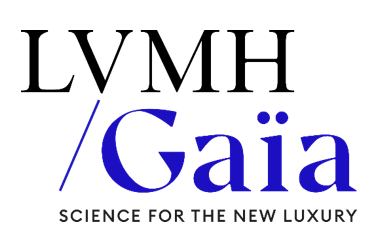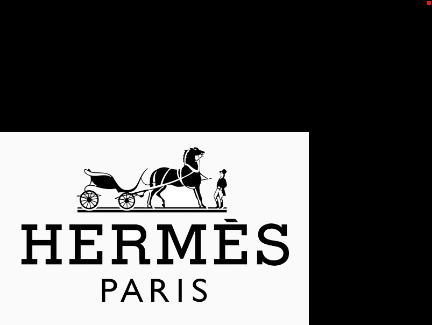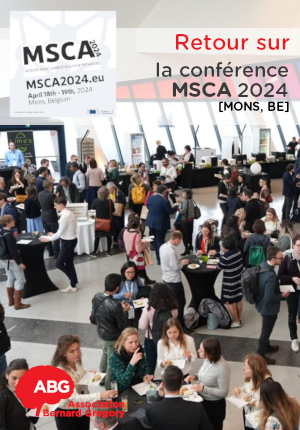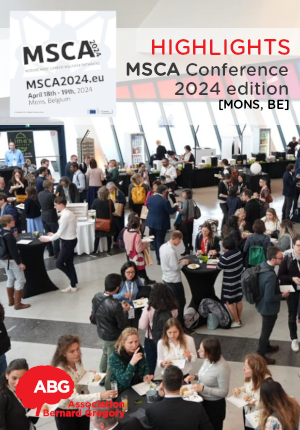Bio-inspired functionally graded laminate layer to maximize flexibility and acting as fracture propagation traps
| ABG-121563 | Sujet de Thèse | |
| 21/03/2024 | Contrat doctoral |
- Sciences de l’ingénieur
Description du sujet
Layered structures have proven to be advantageous in material design, especially for brittle materials such as ceramics. The interest in this topic, which has been extensively studied in the literature in recent decades, has its origins in the brittleness of engineering ceramic materials under tension or bending, despite their otherwise excellent thermomechanical properties [1-2]. Modern engineering materials are often used in critical applications such as aircraft jet engines, where reliability is the most important property and thus sudden, uncontrollable fracture is therefore unacceptable. For these structures, toughness is at least as important as strength, if not more so. It is only recently that physics- and materials-based research focused on the search for materials and/or structures that simultaneously exhibit high strength and toughness. Surprisingly, such structures are frequently found in nature. Biological structural materials such as bone, dentin, tooth enamel, mollusk and crustacean shells and sponge silica skeletons fulfill a variety of mechanical functions, including facilitating locomotion and providing protection from predators and severe environmental conditions. The survival of an organism relies on the mechanical capabilities of structural biomaterials or biominerals. These later are composite or laminate layer materials containing an organic component and nano- or micro-scale amorphous or crystalline minerals. From a materials science perspective, organic molecules are soft, compliant and fracture resistant (tough) while inorganic crystals are hard and brittle. However, these biomineral composites combine the best of these properties and minimize the weaknesses: they are both hard and tough which explains our interest in studying them [3-5].
The proposed PhD project originates from an observational and qualitative examination conducted on Euplectella Aspergium (EA) glass sponges (Hassan’s PhD project- 2022-2025). The glass sponges live in deep sea that explains why it is important for there to resist hydrodynamic forces and be able to cope with uneven loads as the sponge moves in the ocean current. Glass is a brittle and inflexible material that is not traditionally associated with applications where bending is needed. So, how do they adapt to their environment?
When observing a cross-section of a EA spicule, we will notice that it is composed of glass core surrounded by a concentric cylinders glass layers with a thin biological layer sandwiched in between each one. Many previous studies suggest that the concentric glass layers give strength under tension to the spicule, while the biological layers act as a glue, prevent cracks propagating through the entire spicules thickness, and give them flexibility. It is suggested that the organisms drastically enhance by two to three of magnitude the toughness of brittle ceramics, like calcium carbonate or silica, by adding just a few wt.% of organic macromolecules.
This hypothesis, which appears scientifically plausible, has been mentioned many times in different studies but never verified. Our study could help design model multi-layered materials inspired by the structure of the spicule and address question that remain open so far.
Objective and contexte
The goal of this PhD project is to understand how these internal geometric regularity provide sophisticated design solutions that effectively impede fracture propagation in layered laminate structures and maximize the flexibility. Now, if it turns out to be true, is it possible to apply this nano-micro design scale strategy to improve the toughness of engineering composite materials ?
To evaluate the hypothesis, we try to advance on three essential tasks:
1- Initially, there is a task to characterize both EA and MC spicules.
2- Following that, another task pertains to investigating the impact of design on the mechanical properties of lamellar model materials.
3- Lastly, a third task entails employing advanced numerical simulation techniques (FEA), as exemplified in previous research by Zebar et al. [6], to simulate the mechanical behavior of the multilayered material under various conditions.
Supervision
- The PhD work will be supervised by both Ludovic Pauchard (DR, FAST laboratory, CNRS, ParisSaclay University- http://www.fast.upsud.fr/~pauchard/) and Lamine Hattali (MdC, FAST laboratory, CNRS, ParisSaclay University- http://www.fast.upsud.fr/~hattali/).
- We plan to have a regular points (about once a week).
The candidate of Ph.D. thesis will have the opportunity to use, and to familiarize himself with, both the theoretical and experimental techniques developed in these three tasks. This PhD topic, combining both fundamental aspects and potential industrial applications, will permit the candidate to find job openings either in the academic field or in industry.
Host laboratory: FAST Laboratory, Bât 530, rue André Rivière, Campus Universitaire, F-91405 Orsay located 25 km South of Paris, France.
This research project will be benefit in collaboration with academic partners: LMPS laboratory at ENS-PS (Martin Poncelet), LAMPA laboratory at ENSAM Angers (Svetlana Terekhina) and SPEC at CEA-Saclay (Daniel Bonamy).
References
1- M.L Hattali, S Valette, F Ropital, N Mesrati, D Tréheux (2010).. Calculation and experimental determinations of the residual stress distribution in alumina/Ni/alumina and alumina/Ni/nickel alloy systems. J. Mater science 45, 4133-4140
2- M.L Hattali, S Valette, F Ropital, G Stremsdoerfer, N Mesrati, D Tréheux (2009). Study of SiC–nickel alloy bonding for high temperature applications. J. Eur Cera Soc 29 (4), 813-819 (2009).
3- H Gao, B Ji, IL Jäger, E Arzt, P Fratzl (2003) Materials become insensitive to fl aws at nanoscale: lessons from nature. Proc Natl Acad Sci 100:5597-5600
4- P. U. P. A. Gilbert, Mike Abrecht, Bradley H. Frazer (2005). The Organic-Mineral Interface in Biominerals. Reviews in Mineralogy & Geochemistry 59, 157-185.
5- I. Zlotnikov, D. Shilo b, Y. Dauphin, H Blumtritt, P. Werner d, E. Zolotoyabko, P. Fratzl (2013). In situ elastic modulus measurements of ultrathin protein-rich organic layers in biosilica: towards deeper understanding of superior resistance to fracture of biocomposites. RSC Advances, 3, 5798.
6- M.E.M Zebar, M.L Hattali, N Mesrati (2020). Interfacial fracture toughness measurement in both steady state and transient regimes using four-point bending test. Int J Fract 222, 123–135.
Prise de fonction :
Nature du financement
Précisions sur le financement
Présentation établissement et labo d'accueil
Le laboratoire FAST (Fluides, Automatique et Systèmes Thermiques) est une unité mixte de recherche du CNRS (UMR 7608) et de l' Université Paris-Saclay.
Les sujets développés se rattachent à l'hydrodynamique, aux transferts, à la mécanique et à la physique des milieux dispersés.
Les systèmes étudiés sont des fluides simples, multicomposants mais aussi des milieux dispersés macroscopiques (suspensions, granulaires, poreux, fractures…) ou de la matière molle (polymères, colloïdes, gels…).
Les travaux sont basés sur le développement d’expériences (visualisation d’écoulement, traitements d’images quantitatifs, acoustique, gravimétrie haute résolution, rhéologie…) ainsi que de modélisations et de simulations numériques.
Thèmes de recherche
1- Granulaires et Suspensions (responsable: P. Gondret)
- Suspensions fluidisées (ségrégation, ondes...)
- Avalanches et érosion granulaires (rides, dunes...)
- Collisions de grains (forces d’histoire...)
- Ecoulements en tube (intermittence, effet Janssen dynamique...)
2- Milieux Poreux et Fracturés (responsable: L. Pauchard)
- Matière active et biofluidique
- Fluides complexes en milieux poreux
- Matériaux architecturés
- Instabilités mécaniques
3- Convection et transferts (responsable: F. Doumenc)
- Instabilités, convection thermique et solutale dans des fluides complexes
- Convection et séchage appliquée à la compréhension des milieux planétaires
- Evaporation au voisinage d'une ligne de contact, auto-structuration de dépôts
- Films tombants: instabilités, interaction avec un écoulement de gaz
- Climatologie dans les cavités souterraines
4- Instabilités, Ondes et Turbulence (responsable: F. Moisy)
- Ecoulements tournants : ondes d'inertie et turbulence
- Ecoulements à surface libre, ondes et sillages
- Instabilités interfaciales (Kelvin-Helmholtz, Rayleigh-Taylor)
- Ecoulements visqueux, instabilités de flambage
- Turbulence et mélange en fluides miscibles
Site web :
Intitulé du doctorat
Pays d'obtention du doctorat
Etablissement délivrant le doctorat
Ecole doctorale
Profil du candidat
The PhD student will be expected to be interested in an experimental approach in solid mechanics and 3D printing of polymer and ceramic, with skills in data analysis (Excel, Matlab, Abaqus, Python). A good knowledge in English is required and will help for oral presentation in international conferences and for writing scientific articles in international journals.
Vous avez déjà un compte ?
Nouvel utilisateur ?
Vous souhaitez recevoir nos infolettres ?
-
EmploiCDIRef. ABG123470Association Bernard Gregory (ABG)PARIS 3ème - Ile-de-France - France

Créateur et animateur de formations [f/h]
IndifférentNiveau d'expérience indifférent -
EmploiCDIRef. ABG123678LVMH / GaïaParis - Ile-de-France - France

Ingénieur Recherche Nouvelles Matières Maroquinières (H/F)
MatériauxJunior -
EmploiCDIRef. ABG123652HermèsLimoges - Nouvelle Aquitaine - France

CDI – Ingénieur Développement Technique – Responsable d’une Plateforme de Projets R&D – CATE (H/F)
Matériaux - Génie des procédésNiveau d'expérience indifférent














